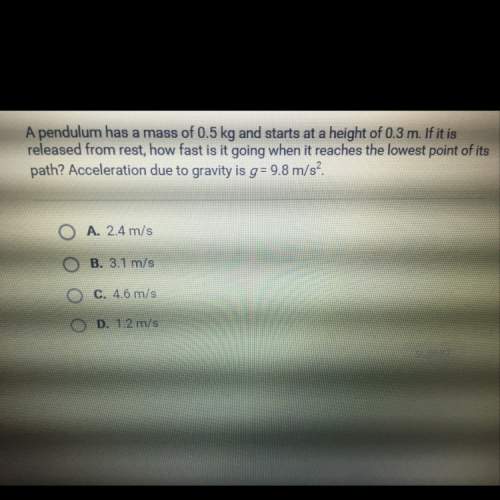
Physics, 26.11.2019 21:31 omidbromand786
Consider the following descriptions of the vertical motion of an object subject only to the acceleration due to the gravity.
(note: the acceleration due to the gravity is 9.8m/s^2.)
a.) find the velocity of the object for all relevant times.
b.)find the position of the object for all relevant times.
c.) find the time when the object reaches the highest point (what is the height)?
d.) find the time when the object strikes the ground.
a payload is released at an elevation of 400m from an hot-air balloon that is at a rising rate of 11m/s

Answers: 3
Another question on Physics

Physics, 22.06.2019 01:00
First, launch the video below. you will be asked to use your knowledge of physics to predict the outcome of an experiment. then, close the video window and answer the question at right. you can watch the video again at any point. part a as in the video, we apply a charge +q to the half-shell that carries the electroscope. this time, we also apply a charge –q to the other half-shell. when we bring the two halves together, we observe that the electroscope discharges, just as in the video. what does the electroscope needle do when you separate the two half-shells again? view available hint(s) as in the video, we apply a charge + to the half-shell that carries the electroscope. this time, we also apply a charge – to the other half-shell. when we bring the two halves together, we observe that the electroscope discharges, just as in the video. what does the electroscope needle do when you separate the two half-shells again? it deflects more than it did at the end of the video. it deflects the same amount as at end of the video. it does not deflect at all. it deflects less than it did at the end of the video. submit
Answers: 2

Physics, 22.06.2019 02:30
The particle in a two-dimensional well is a useful model for the motion of electrons around the indole ring (3), the conjugated cycle found in the side chain of tryptophan. we may regard indole as a rectangle with sides of length 280 pm and 450 pm, with 10 electrons in the conjugated p system. as in case study 9.1, we assume that in the ground state of the molecule each quantized level is occupied by two electrons. (a) calculate the energy of an electron in the highest occupied level. (b) calculate the frequency of radiation that can induce a transition between the highest occupied and lowest unoccupied levels. 9.27 electrons around the porphine ring (4), the conjugated macrocycle that forms the structural basis of the heme group and the chlorophylls. we may treat the group as a circular ring of radius 440 pm, with 20 electrons in the conjugated system moving along the perimeter of the ring. as in exercise 9.26, assume that in the ground state of the molecule quantized each level is occupied by two electrons. (a) calculate the energy and angular momentum of an electron in the highest occupied level. (b) calculate the frequency of radiation that can induce a transition between the highest occupied and lowest unoccupied levels.
Answers: 1

Physics, 22.06.2019 15:20
Acarpenter builds an exterior house wall with a layer of wood 2.9 cm thick on the outside and a layer of styrofoam insulation 2.3 cm thick on the inside wall surface. the wood has k=0.080w/(m⋅k), and the styrofoam has k= 0.010 w/(m⋅k). the interior surface temperature is 19.0 ∘c , and the exterior surface temperature is -15.0 ∘c . a.)what is the temperature at the plane where the wood meets the styrofoam? celsius b.)what is the rate of heat flow per square meter through this wall? /m^2
Answers: 2

Physics, 22.06.2019 16:00
The field between two charged parallel plates is kept constant. if the two plates are brought closer together, the potential difference between the two plates either a) decrease b) does not change c) increase?
Answers: 3
You know the right answer?
Consider the following descriptions of the vertical motion of an object subject only to the accelera...
Questions


Mathematics, 21.12.2020 21:10


Chemistry, 21.12.2020 21:10


Mathematics, 21.12.2020 21:10




Mathematics, 21.12.2020 21:10

Mathematics, 21.12.2020 21:10


Mathematics, 21.12.2020 21:10

Mathematics, 21.12.2020 21:10

Spanish, 21.12.2020 21:10


English, 21.12.2020 21:10

English, 21.12.2020 21:10

Chemistry, 21.12.2020 21:10

Mathematics, 21.12.2020 21:10




